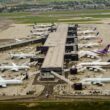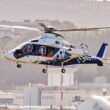It will soon be 11 years since I began my journey in aviation. On the 10th of May 2010, I began working at the International Air Transport Association (IATA) Training and Development Institute in Geneva, where I was in charge of coordinating classroom training courses. Aviation came to me by chance as part of finishing my Master’s degree in International Affairs at the Graduate Institute of International and Development Studies (IHEID). However, I soon realised that nothing is a coincidence, and because of this I embraced the aviation world with all of its challenges and opportunities.
As a training coordinator at IATA, I would have the opportunity to meet participants and instructors that travelled from near and far to attend the Association’s training courses. This has been such a powerful way for me to learn about the industry. Above all, what I gathered through these interactions, was the quality of the people. The industry has a tremendous capacity to attract skilled and motivated people who carry with them much respect for their jobs and a vision for the future. I well remember these engaging interactions, challenging debates, and meeting people who would travel the world to gain knowledge and make new connections.
As I moved towards a content-related role within IATA, which involved overseeing Airline Management, Aviation Law, Environment, and furthering the Leadership & Development portfolio of courses, it struck me how much aviation is dependent on training. The industry was growing at a high speed while new aviation professionals needed training to develop and fine-tune their skills. To stay relevant in aviation, learning is paramount, both for the more regulated areas such as safety or dangerous goods, but also for management and commercial roles.
The majority of aviation professionals have been, to an extent, impacted by the crisis. According to the IATA, more than 25 million jobs (out of the total of 65.5 million jobs supported by the industry) are currently in jeopardy, with all worldwide regions being affected. The sad reality is that classroom training was downgraded, firstly because of the complicated set up of face-to-face delivery, and secondly because of limited resources.
I genuinely believe that this was a positive thing. A wake-up call for learning and development professionals that are adapting to the new reality, and who were forced to devise a different training strategy. Online training is no longer an option, but a necessity, and asynchronous training – which in the past felt ‘cheap’ – is now the primary means of conveying information.
People found ways to stay up to date via virtual classes, webinars, videos, microlearning, phone calls, and other inventive strategies. The crisis accelerated the need to diversify the delivery methods within aviation training.
Asynchronous training is becoming more immersive; training at the point of need is the norm even in an industry that is highly regulated. Ironically, one of the first e-learning courses was developed within aviation in the mid-1980s. According to Dr. S Kearns in ICAO Training Report Vol 5 no 1, this technology was a computer-based Air Force electronics practice tool, called ‘Sherlock’8, that was created as an environment where technicians could practice their troubleshooting skills. Since then we’ve seen other applications of technology in learning such as ground handling augmented reality systems, navigation systems for pilots (landing, taxiing) etc.

Anca Gosling, Director Training Content & Development at Aeroclass.org / Avia Solutions Group
Technology has no limits. This new perspective of training is what motivated me to take up the challenge at Aeroclass.org in March 2021, where the vision is to train aviation professionals anywhere and anytime using the latest technology available. At Aeroclass.org we put the newest technologies at the forefront of our training design to provide the best user experience for aviation professionals.
Research published by the World Economic Forum back in 2020 concluded that the COVID-19 pandemic has changed the education sector forever. Whether it is language apps, virtual tutoring, or online learning software, there has been a significant increase in usage since the start of the crisis. This gives rise to the question, could the move to online learning be the beginning of a new era in educating aviation professionals? While researchers are divided over an answer, one highly acceptable truth is that aviation training is at a crossroads.
Across the aviation sector, companies are being forced to reconsider their L&D plans and their learning strategies for the coming years. Personally, I think that the use of technology (Augmented Reality, Virtual Reality, Gamification etc.) will only serve to benefit the industry. What I learned from the lockdown was that aviation professionals are eager to stay up to date and connected, thus, more than ever training is in demand.
The Aeroclass.org value proposition is to bring training closer to people by creating affordable, easy to access anywhere/anytime training. This will not only help aviation professionals to transition the crisis successfully but will also empower these professionals to be ready when the time comes to get back to work.
What motivates me most, is being able to give something back and make a difference to the aviation professionals who have been affected by the crisis. I firmly believe that the industry will emerge even stronger and more innovative after the crisis, and above all, that covid-19 will come to be regarded as an accelerator for aviation training and development.









